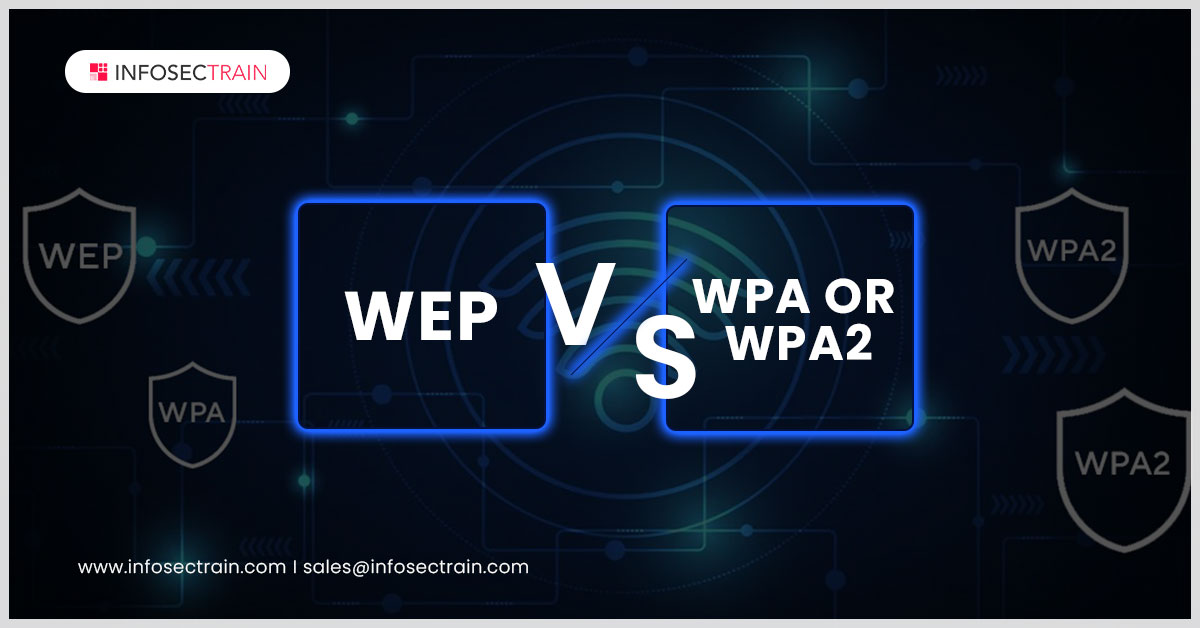WEP Vs. WPA or WPA2
Wireless Fidelity (Wi-Fi) is predominantly used everywhere to connect several devices, such as mobile phones, laptops, tablets, computers, and other devices, with a single network. Since many devices are connected to the network, wireless security concerns are taking over to protect the network from unauthorized access. In this comprehensive blog, we will discuss the WEP, WPA, and WPA2 Wi-Fi security protocols used to secure network connections.

Table of Contents
What are the Wi-Fi Security Protocols?
What is Wired Equivalent Privacy (WEP)?
What is Wi-Fi Protected Access (WPA)?
What is Wi-Fi Protected Access 2 (WPA 2)?
WEP Vs. WPA or WPA 2
What is Wi-Fi Protected Access 3 (WPA 3)?
How to check the Wi-Fi Security protocol?
What are the Wi-Fi Security Protocols?
Wi-Fi security protocols secure the network connections and protect the user’s data using encryption technology. It also uses cryptographic keys to modify data and convert it into indecipherable. The Wi-Fi security system uses symmetric encryption methods to encrypt and decrypt the data.
The Wi-Fi Alliance accredits four different types of Wi-Fi security protocols. They are as follows:
- Wired Equivalent Privacy (WEP)
- Wi-FI Protected Access (WPA)
- Wi-Fi Protected Access 2 (WPA 2)
- Wi-Fi Protected Access 3 (WPA 3)
What is Wired Equivalent Privacy (WEP)?
Wired Equivalent Privacy (WEP) is the earliest Wi-Fi security protocol developed in 1997. It uses a single key to protect the network and aims to provide security to wireless networks. After a time, WEP found that the 40-bit encryption key used in WEP was vulnerable and unsafe. Among all other Wi-Fi security protocols, WEP is considered the least secure. So, the Wi-Fi Alliance officially discarded the WEP in 2004, and modern Wi-Fi routers didn’t have the WEP option anymore.
Advantages of WEP
- WEP protects from man-in-the-middle attacks.
- It is simple and easy to set up.
Disadvantages of WEP
- WEP provides a static encryption key, which is required to be changed manually.
- It has many security vulnerabilities and provides less security.
What is Wi-Fi Protected Access (WPA)?
To overcome the issues with WEP, Wi-Fi Protected Access (WPA) was developed in 2003 with added and strengthened security features, such as Temporal Key Integrity Protocol (TKIP). It includes a 256-bit dynamic key for encryption, and that is a significant change in WPA from WEP. WPA is more secure when compared to WEP, but to meet today’s security requirements, WPA has been outdated. Even the TKIP encryption method has some vulnerabilities which a hacker can exploit.
Advantages of WPA
- WPA provides a TKIP encryption method that changes the key dynamically.
- It offers better security than WEP.
- It identifies security vulnerabilities.
Disadvantages of WPA
- Even TKIP has some security vulnerabilities which hackers can exploit.
- It is comparatively less secure than WPA2.
What is Wi-Fi Protected Access 2 (WPA 2)?
WPA 2 was developed to provide better security than WPA with added features and upgrades altogether. It is a successor to WPA, which replaces the TKIP encryption method with the Advanced Encryption System (AES). AES uses a symmetric encryption algorithm that is strong enough to resist brute-force attacks. The WPA 2 has achieved popularity in securing a top protocol position since 2004. The US Federal Government has adopted encrypting sensitive government data using WPA. Also, in 2006, the Wi-Fi Alliance announced that it is mandatory to use WPA 2 for all potential Wi-Fi devices.
Advantages of WPA2
- WPA 2 provides a better security level.
- It uses the AES encryption method, which offers a robust cipher method.
- It provides 256-bit key encryption.
Disadvantages of WPA2
- It consumes more processing power.
- It also has some security vulnerabilities.
WEP Vs. WPA or WPA 2
WPA 2 is the most secure wireless security protocol compared to the other two earlier security protocols. It is also the best and most mandatory option that is most widely used. Let’s take a look at their differences:
| Specification | WEP | WPA | WPA 2 |
| Inception | 1997 | 2003 | 2004 |
| Session key size | 64-bit/128-bit | 256-bit | 256-bit |
| Encryption method | Fixed-key | TKIP | AES |
| Authentication method | Open system/Shared Key | Pre-Shared Key | Pre-Shared Key in Personal and Enterprise mode |
| Cipher Type | RC4 stream cipher | TKIP (RC4-based) | Counter mode with Cipher Block Chaining Message Authentication Code Protocol (CCMP) |
| Data Integrity | Cyclic Redundancy Check | Message Integrity Check | Message Integrity Check |
| Key Management | Symmetric key encryption | WPA + WPA-PSK | WPA2- Personal (WPA2-PSK)
WPA2- Enterprise (WPA2-EAP) |
What is Wi-Fi Protected Access 3 (WPA 3)?
The Wi-Fi Protected Access 3 (WPA 3) is the latest wireless security protocol designed to encrypt the data automatically using Perfect Forward Secrecy, which provides a frequent and automatic encryption type. It offers robust security to the network and prevents hackers from exploiting the data.
How to check the Wi-Fi Security protocol?
To check your Wi-Fi security protocol, do the following:
- Open the Windows Start menu.
- Type Wi-Fi settings, and open it.
- Go to the connected Wi-Fi network and click properties.
CompTIA Network+ from InfosecTrain
InfosecTrain is one of the best certification training providers, specializing in Cybersecurity and Information Security domains. It offers a CompTIA Network+ certification course that helps you achieve the necessary skills to install, configure, manage, maintain, and troubleshoot computer networks. If you want to become a Network Administrator, get enrolled, trained, and certified with InfosecTrain.




 1800-843-7890 (India)
1800-843-7890 (India) 
